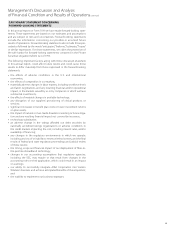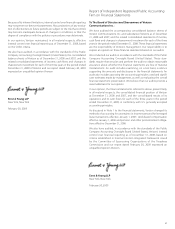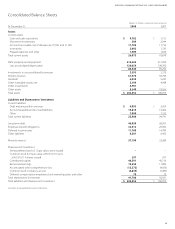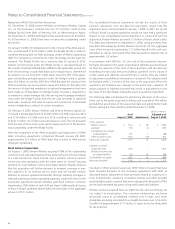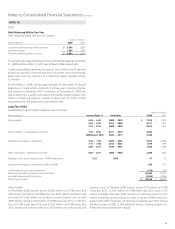Verizon Wireless 2008 Annual Report Download - page 47
Download and view the complete annual report
Please find page 47 of the 2008 Verizon Wireless annual report below. You can navigate through the pages in the report by either clicking on the pages listed below, or by using the keyword search tool below to find specific information within the annual report.Notes to Consolidated Financial Statements continued
45
On February 12, 2008, FASB issued FASB Staff Position (FSP) No. FAS
157-2, Effective Date of FASB Statement No. 157 (FSP 157-2), which delays
the effective date of SFAS No. 157 for one year for all nonfinancial assets
and nonfinancial liabilities, except those that are recognized or disclosed
at fair value in the financial statements on a recurring basis. We elected
a partial deferral of SFAS No. 157 under the provisions of FSP 157-2
related to the measurement of fair value used when evaluating good-
will, other intangible assets, wireless licenses and other long-lived assets
for impairment and valuing asset retirement obligations and liabilities
for exit or disposal activities. On October 10, 2008, the FASB issued FSP
157-3, Determining the Fair Value of a Financial Asset When the Market for
That Asset Is Not Active, (FSP 157-3), which clarifies application of SFAS
No. 157 in a market that is not active. FSP 157-3 was effective upon issu-
ance, including prior periods for which financial statements have not
been issued. The impact of partially adopting SFAS No. 157 on January
1, 2008 and the related FSPs 157-2 and 157-3 was not material to our
financial statements.
SFAS No. 159
SFAS No. 159, The Fair Value Option for Financial Assets and Financial Liabilities
- Including an Amendment of SFAS No. 115 (SFAS No. 159), permits but does
not require us to measure financial instruments and certain other items
at fair value. Unrealized gains and losses on items for which the fair value
option has been elected are reported in earnings. As we did not elect to
fair value any of our financial instruments under the provisions of SFAS No.
159, our adoption of this statement effective January 1, 2008 did not have
an impact on our consolidated financial statements.
Income Taxes
Verizon and its domestic subsidiaries file a consolidated federal income
tax return.
Deferred income taxes are provided for temporary differences in the
bases between financial statement and income tax assets and liabilities.
Deferred income taxes are recalculated annually at rates then in effect.
We record valuation allowances to reduce our deferred tax assets to the
amount that is more likely than not to be realized.
Effective January 1, 2007, we adopted FASB Interpretation No. 48,
Accounting for Uncertainty in Income Taxes (FIN 48), which requires the
use of a two-step approach for recognizing and measuring tax benefits
taken or expected to be taken in a tax return and disclosures regarding
uncertainties in income tax positions. The first step is recognition: we
determine whether it is more likely than not that a tax position will be
sustained upon examination, including resolution of any related appeals
or litigation processes, based on the technical merits of the position. In
evaluating whether a tax position has met the more-likely-than-not rec-
ognition threshold, we presume that the position will be examined by
the appropriate taxing authority that has full knowledge of all relevant
information. The second step is measurement: a tax position that meets
the more-likely-than-not recognition threshold is measured to determine
the amount of benefit to recognize in the financial statements. The tax
position is measured at the largest amount of benefit that is greater than
50 percent likely of being realized upon ultimate settlement. Differences
between tax positions taken in a tax return and amounts recognized in
the financial statements will generally result in one or more of the fol-
lowing: an increase in a liability for income taxes payable, a reduction of
an income tax refund receivable, a reduction in a deferred tax asset, or
an increase in a deferred tax liability.
As a result of the implementation of FIN 48, we recorded adjustments
to liabilities that resulted in a net $79 million increase in the liability for
unrecognized tax benefits with an offsetting reduction to reinvested
earnings as of January 1, 2007. The implementation of FIN 48 also resulted
in adjustments to prior acquisitions accounted for under purchase
accounting, resulting in a reduction in the liability for tax contingencies
in the amount of $635 million and corresponding reductions to good-
will and wireless licenses of $100 million and $535 million, respectively.
The implementation impact included a reduction in deferred income
taxes of approximately $3 billion, offset with a similar increase in Other
liabilities as of January 1, 2007.
FASB Staff Position (FSP) No. FAS 13-2, Accounting for a Change or Projected
Change in the Timing of Cash Flows Relating to Income Taxes Generated by
a Leveraged Lease Transaction (FSP 13-2), requires that changes in the
projected timing of income tax cash flows generated by a leveraged
lease transaction be recognized as a gain or loss in the year in which
the change occurs. We adopted FSP 13-2 effective January 1, 2007. The
cumulative effect of initially adopting FSP 13-2 was a reduction to rein-
vested earnings of $55 million, after-tax.
Stock-Based Compensation
Effective January 1, 2006, we adopted SFAS No. 123(R), Share-Based
Payment (SFAS No. 123(R)) utilizing the modified prospective method.
SFAS No. 123(R) requires the measurement of stock-based compensa-
tion expense based on the fair value of the award on the date of grant.
Under the modified prospective method, the provisions of SFAS No.
123(R) apply to all awards granted or modified after the date of adoption.
The impact to Verizon resulted from the Domestic Wireless segment, for
which we recorded a $42 million cumulative effect of accounting change
as of January 1, 2006, net of taxes and after minority interest, to recog-
nize the effect of initially measuring the outstanding liability for Value
Appreciation Rights (VARs) granted to Domestic Wireless employees at
fair value utilizing a Black-Scholes model.
Foreign Currency Translation
The functional currency of our foreign operations is generally the local
currency. For these foreign entities, we translate income statement
amounts at average exchange rates for the period, and we translate
assets and liabilities at end-of-period exchange rates. We record these
translation adjustments in Accumulated other comprehensive loss, a
separate component of Shareowners’ Investment, in our consolidated
balance sheets. We report exchange gains and losses on intercompany
foreign currency transactions of a long-term nature in Accumulated
other comprehensive loss. Other exchange gains and losses are reported
in income.


